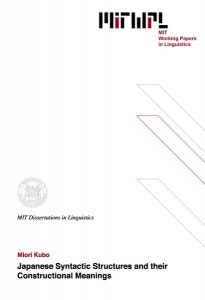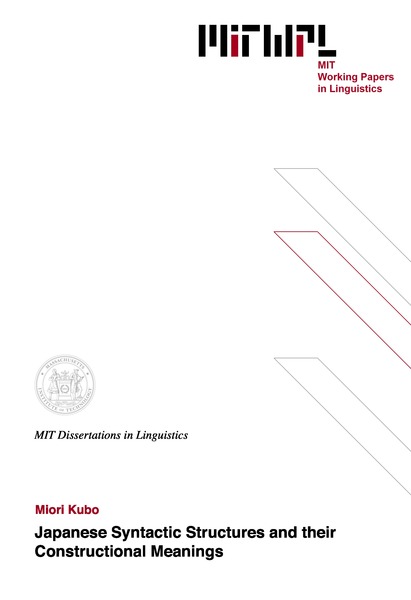Japanese Syntactic Structures and Their Constructional Meanings
M. Kubo, 1992
This dissertation explores the sentential structure of Japanese, of both matrix and embedded clauses, with special attention given to the configurational relation between a predicate head X0 and its arguments. It is argued that two quite distinct sentential forms, IP and CP, are possible in Japanese. A leading idea pursued here is that crucial factors determining the configurational relations are (i) whether a head goes through syntactic head movement (Travis 1984, Baker 1988) and (ii) whether a head is syntactically filled or empty (Emonds 1985). Among the sentence types researched are included not only sentences with single verbs, but also predicate attribute sentences, complex verb sentences containing causative, desiderative and potential suffixes, and a representative range of embedded sentences.
In relation to head movement, I argue for a strict structural case marking analysis in the spirit of Takezawa (1987) and Morikawa (1989) and show that the configurational relations between case-assigning heads and NPs are directly mirrored by morphological case. Both Spec-Head agreement and government are motivated as case assigning mechanisms, the former being reserved, however, for only subject-predicate relations. A central discovery here is that the functional categories in Japanese, C, I, and D, each uniformly assign one and only one so-called nominative case ga; this in turn supports the existence of functional categories as a class.
Another effect of head movement, via case marking, relates to possible positions for subjects and their associated configurational meanings. That is, the two well-known interpretations of NP-ga, neutral and exhaustive, are argued to result from them occupying different positions in SPEC(I) and SPEC (C). The distributional distinctions between SPEC(C) and SPEC (I) are in turn determined by positions of the corresponding heads, which are governed by various syntactic constraints. In the course of investigation, quite interesting parallels, until now obscured, are brought out bewteen noun phrases and sentences.
This research can be taken as a concrete effort to investigate various structural configurations and their configurational meanings, on the basis of the idea that meaning is in essential parts simply form. Among the contrasts investigated are activity vs. stative verbs, exhaustive vs. neutral interpretations of NP-ga, and the differing syntactic and interpretive behaviors of the two clausal types CP and IP. In a final chapter, I motivate a correlation between these two clausal structures and Kant’s two types of judgments, analytic and synthetic.
Thesis Supervisor: Noam Chomsky
Title: Institute Professor
Table of Contents
Chapter 1 Introduction: Subjects and Predicates in Japanese 10
1.1 The topic marker wa and nominative ga 10
1.2 A structural case marking system: preview 16
1.3 Subject interpretation and sentential structure 19
Chapter 2 The Interpretations and Structures for Nominative Case 22
2.1 (In)compatibilities among neutral ga, exhaustive ga, and thematic
wa 22
2.2 Concerning the distribution of exhaustive and neutral ga 32
2.2.1 An effect of constrative stress 34
2.2.2 Correlations between the interpretations of subjects and of
predicates 37
Chapter 3 Position of the Verb as Structural Determinant 42
3.1 Differences between activity and stative verbs 43
3.2 Object case marking and the position of the verb 45
3.2.1 A contrast in object case marking 45
3.2.2 A V-raising analysis of stative verbs 47
3.2.3 Causatives and case marking 54
3.3 On so-called gerundive forms 62
3.3.1 The progressive form as a criterion for stativity 62
3.3.2 Examples of the gerundive form 69
3.3.3 Structure for the gerundive form 74
3.3.4 Stative verbs and the aspectual participles 76
3.3.5 Other constructions with –te 78
3.3.5.1 V’-coordination 78
3.3.5.2 IP-Subordinate Clauses with –te 82
3.3.6 Summary 83
3.4 Case and interpretation of subjects 84
3.4.1 Case marking through agreement and government 84
3.4.2 Subject interpretation in VP-centered sentences 86
3.5 The constructional meaning of I with incorporated V 87
Chapter 4 Suru-support and the CP Projection 91
4.1 Japanese suru-support and English do-support 91
4.2 A syntactic structure for the suru-support construction 97
4.3 Summary 102
Chapter 5 Structures of Predicate Attribute Sentences 105
5.1 Free and bound adjectives 106
5.1.1 External structure of adjectives and adjectival nominals 106
5.1.2 The syntactic category of so-called adjectives and adjectival
nominals in Japanese 110
5.1.3 Borrowing and morphology 119
5.2 Structure of predicate attribute sentences 121
5.2.1 The predicate head 121
5.2.2 The free copula in I and C 124
5.2.3 Structures of the bound adjective-centered sentences 130
5.2.4 Subject interpretation in predicate attribute sentences 131
5.3 Aru-support 133
5.3.1 Structure of the aru-support construction 133
5.3.2 Aru-support as a device to ensure the synthetic form 138
5.3.3 Difference between aru-support and suru-support 139
5.4 Summary: three types of sentence form 141
Chapter 6 Domains and Effects of Head Movement 145
6.1 The paradigms in question and previous treatments 145
6.2 All three syntactic structures manifested in the potential
construction 148
6.2.1 The potential morpheme base-generated under I 148
6.2.2 The three case-marking patterns correspond to three
positions of the predicate head 154
6.2.3 Object case alternation and the position of the verb 159
6.2.4 Interpretations of analytic and synthetic forms 162
6.2.5 Summary 165
6.3 The desiderative construction 167
6.3.1 The status of the desiderative morpheme 167
6.3.2 Case alternation with tai and the position of the verb 169
6.3.3 A difference in the predicate head, A or V 177
6.4 A difference between potential and desiderative constructions 180
6.5 Summary 185
Chapter 7 Subordinate Clauses 188
7.1 Subordinate clauses whose complements are CPs 191
7.2 Subordinate clauses whose complements are IPs 199
7.3 Subordinate clauses and nominative case inside of NP 210
7.3.1 Examination of clausal size 210
7.3.2 The structure of simple NP 215
7.3.3 The structure of NPs containing sentential complements 222
7.3.4 The structure of relative clauses 228
7.3.5 Summary 234
Chapter 8 Sentence Forms and Interpretations 235
8.1 Formal vs. natural systems 238
8.2 Constructional meanings 242

